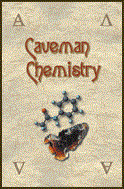 OST has posted a new article introducing the book Caveman Chemistry, by Dr. Kevin Dunn. “Starving the Monkeys” readers will recognize this book from our recommended reading list; we use it all the time for our homeschool chemistry lab manual to supplement text books. If you only have room on your self-sufficiency shelf for one chemistry book, this one is it. Worst-case, you will be able to get future generations up to a greater-than-high-school level of chemistry knowledge quickly, and at the same time be able to create useful materials for a higher quality of life.
OST has posted a new article introducing the book Caveman Chemistry, by Dr. Kevin Dunn. “Starving the Monkeys” readers will recognize this book from our recommended reading list; we use it all the time for our homeschool chemistry lab manual to supplement text books. If you only have room on your self-sufficiency shelf for one chemistry book, this one is it. Worst-case, you will be able to get future generations up to a greater-than-high-school level of chemistry knowledge quickly, and at the same time be able to create useful materials for a higher quality of life.
If you have room for two books, add a high-school chemistry text from the 70s back. We use the first edition of “Modern Chemistry”, by Metcalfe, et. al., published in 1974. Which one you get doesn’t matter so much as it needs to be from before carbon turned into a villain. The better texts from that era have a tour of all the elemental groups and explain what uses each element or group has.
The third chemistry book should bridge the gap between ancient alchemy and modern chemistry, particularly regarding what old compounds are what modern equivalents and how to make them. For example, the alchemical oil of vitriol is sulfuric acid, muriate of potash is potassium chloride and so on. Having a guide for this is very helpful, especially since a lot of chemicals were synthesized locally by nineteenth century pharmacists using common materials or a relatively small set of inexpensive feedstocks.
For this third book, we use “Granddad’s Wonderful Book of Chemistry” by Kurt Saxon. This one is very expensive online, so I wouldn’t get it from Amazon. If you run across copies in a used book store somewhere, make sure to grab it. However, Saxon created his book by incorporating a lot of material from nineteenth century texts. Finding those would be like finding gold, and many of these have been scanned and are online. These old texts will also show how to make labware and perform various procedures with primitive tools and materials.
One thing that is missing in a lot of the information out there is the entire field of electrochemistry and electrophoresis, which access to solar panels and buck converters make possible. Stay tuned.
Update 30 Nov 2016: Thanks to everyone who has sent in links for downloads of various texts. We’ve tried to verify some of these as public domain but have been unable to get in contact with the publishers. So, we haven’t published these links. Anyone who wants to download these things can probably find them on their own, but thanks again.
Leave a Reply
1 Comment on "Introducing Caveman Chemistry"
“Modern Chemistry”, by Metcalfe, can be found USED at Barnes and Noble website for $6.43 which includes shipping…..